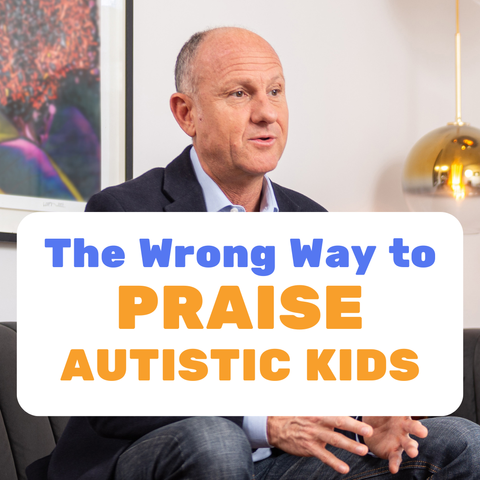AIM : Stare More!
Listen to this week’s A.I.M
on the audio player below
We’re all taught to not stare at others because it’s rude.
But did you know that kids who stare more, learn more? Yep! And did you know that humans are hardwired at birth to stare? So when your parents and grandparents told you to stop staring, they were asking you to fight against a natural reflex, an unconscious urge, to watch others!
In fact there are regions of your brain dedicated just to watching and learning from others. But why would our brains evolve like this?
Well, listen in for the next few minutes as I explain why it’s so important to let young children stare. Why some children with autism need to be taught to do it more, and what researchers at Emory University have learned about our brian. I promise, you’ll enjoy the next 5 minutes to get your A.I.M. for this week.
Lunch and Learn
So, I was at a Chipotle restaurant for lunch when a young family sat at the table beside me. They put their one and a half year-old infant in a highchair with his back to me, but instead of paying attention to his food, he kept turning around to watch me! In fact he stared at me for half of my lunch!
I admit, I smiled and made a few faces at him which probably peaked his interest. I mean who can resist smiling and waving and making faces at a baby watching you to try to get them to smile. Come on… admit it… you’ve done it too!
And even though I learned in child psychology courses that this is typical infant behavior, I was amazed at how much effort he invested to turn his entire torso in the highchair, and not eat his own food, just to watch me eat. I’m not that interesting of an eater. In fact my friends say I’m one of the slowest chewers they know!
But whether you’re interesting or not, it turns out that babies as young as six days old are hardwired to watch people. A hallmark behavior of almost all children is observing others. And researchers believe that our brains have evolved to be particularly attentive to others so early on to learn critical social skills to survive.
Watching what others do and say is the main way we learn to socialize.
So, my little buddy at the Chipotle restaurant was learning as he stared at me. I wonder if he’ll grow up to be a slow chewer too?
The Science
Child psychologists and biologists are trying to figure out how all of this all works in hopes of gaining insights into what might be going on for children who don’t learn social skills easily… like autistic children. One study at Emory University showed that infants as young as four months old have a region of the brain in the visual cortex they call the “face network” dedicated to observing and codifying social behavior.
We use this brain region to learn communication, facial expressions, emotions, non-verbal behavior, and eye contact by observing others.
To support how all this works, a paper published by a group of researchers led by Parma University in Italy presented evidence of motor neurons in neonates. Motor neurons are highly specialized brain cells that play a central role in the “observe-imitate” reflex. Children watch what others do and then they imitate - they try to do it themselves. And these special mirror neurons make this happen and have been found in neonates. This means, children who are in just the first four weeks after birth have been shown to observe and then try to imitate social behavior!
Autism
I think I’m amazed each time a child stares at me in large part because I’ve worked closely with hundreds of autistic children who rarely stare. In fact, they often actively turn away. Some first-hand accounts explain that it can feel painful or disorienting for an autistic person to look at human faces. But the autistic population is so diverse that this isn’t true to everyone.
What I’ve found is that a gentle, playful and non-pushy approach works best to encourage autistic children to look more at others. Sometimes we start by simply looking at photos of real people in books. We point out their facial expressions and the actions they are doing. We then progress to watching video, but always of real people, not cartoons. We might casually point out what we observe. And then we might model how to imitate what we saw in the video or book.
We also aren’t shy to sit with them on a park bench or in a playground to teach them to observe. Think about it: the majority of autism therapy is focused on getting the kids to do things. “Draw a circle”, “build a lego tower”, “zip your coat up”, and dozens of other directions every day. But what about observing? With so much focus on doing, there is very little time for just watching. Yet that’s what neurotypical children do for hours every day. They watch others.
So we believe we can accelerate social skills learning by first teaching autistic children to observe more. We literally teach the observe-imitate reflex! We engage our autistic students in observe-imitate games. And we are on the lookout always for any evidence that they are watching us and imitating us so we can show our excitement and approval with positive reinforcement.
This week, your A.I.M. is to encourage your child to watch you and others more. As you’re cooking dinner you could casually invite them to watch you stir the soup or watch you turn on the tap or watch you cut the carrots.
Children aren’t shy to ask their parents and friends to “watch me!” as they move down a slide or show off a bit. This week, you could model this kind of natural language: say “Watch me!” or “Watch this!” And then make sure to celebrate when they do.
Another idea is to narrate what you see others doing as you drive through the neighbourhood. “Hey, look at that person walking with their dog”, for example. The idea here is to call your child’s attention to what others are doing.
A.I.M. to observe and imitate this week.
Have fun!

Jonathan Alderson
Autism Expert
Founder, ThriveGuide
Author, Challenging the Myths of Autism
What do you think of this week's AIM?

Jonathan Alderson
Autism Expert
Founder, ThriveGuide
Author, Challenging the Myths of Autism
Your AIM: Break the Habit!
On the go? Listen instead of read!
We are all creatures of habit. We just are.
You have a morning routine at your bathroom sink. Do you drink a glass of water first or brush your teeth first? Maybe you splash your face with water, or maybe the very first thing you do is turn on your radio to listen while you start the bathroom routine.
Your child is no different.
And, as you know, people with autism tend to stick to their habits and routines even more fiercely.
Habits are efficient. They help us to get through the day quickly and also to multi-task, because we don’t need much brain power to do familiar routines.
Share this week's AIM
Explore all AIMs:
Know what to do and when.
Actionable goals to best support your unique child, each prioritized so you know what do to first.
Maximize your resources.
Less than the cost of a single therapy session.
Start right away. No waitlists.
Practical strategies you can do at home.
Know what to do and when.
Actionable goals to best support your unique child, each prioritized so you know what do to first.
Maximize your resources.
Less than the cost of a single therapy session.
Start right away. No waitlists.
Practical strategies you can do at home.
Completely Risk-Free! 100% Money Back Guarantee

























